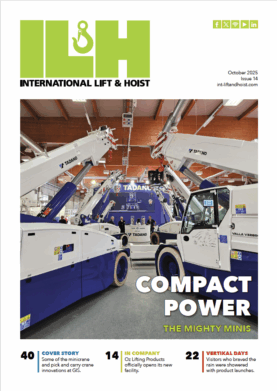)
Greater awareness needed on one trip slings
A general lack of understanding over ‘one trip’ and low quality slings is threatening safety in the construction, timber and steel sectors as well as in ports and docks, warns Dave Cormack, board member of The Lifting Equipment Engineers Association (LEEA).
The term ‘One Trip Sling’ is given to a sling that has been designed for the specific purpose of attaching to and accompanying a specific load from source, through a defined number of handling operations, until it reaches its final destination. Once this trip has concluded the sling must be destroyed and not reused. Duty holders will be culpable for non-conformance.
One of the main routes for one trip slings into a country is via ship’s cargo being discharged in ports. Unfortunately, a lack of awareness is giving many of these slings free passage out of the docks, where they should be destroyed once removed from the cargo. They are often mixed in with general purpose slings on construction sites, timber yards or a steel stockholder’s facilities. This is where there is an increased risk of accidents.
Staff may see a one trip sling lying around these sites, which they perceive to be relatively new and think that it would be practical to reuse it to sling a load of material. Or rather than seeing a sling go to waste they might throw it back into their tool box or equipment stores and use it for weeks or months without realising that it is not designed for general purpose use and is, therefore potentially, unsafe. That is until somebody points it out or, more seriously, when something goes tragically wrong.
Because the reality is that such actions put users at risk at the other end of the sling’s trip. It also affects the employer because in the event of an accident, they would be asked why they allowed a one trip sling to be used for general purpose lifting.
This issue is not only with slings designed specifically as one trip but also with those that do not meet the required standard or quality. A sling made to an industry standard in one country may not comply in another.
For example, the EU Machinery Directive says that general purpose slings must have a safety factor of 7 to 1, for the UK and the rest of Europe. US regulations only require a 5 to 1 factor. When a sling bought in the US and manufactured to US regulations arrives in the UK, it will not meet UK or EU compliance so will need to be controlled in a similar manner to a one trip sling.
Users also need to be made aware that low quality slings, manufactured without complying with any standards, are also out there and must ensure these do not find their way into general purpose use.
The capacity of general purpose slings can be identified by the colour. Many one trip slings are made from white webbing, however many half tonne or intermediate capacity slings are also white or even black. So it is vitally important to educate people that, because a sling is assumed to be one trip, it isn’t necessarily so. LEEA advises that colour should never be used to identify a sling’s WLL (Working Load Limit) – the label should always be checked.
To be clear, one trip slings are legal and are absolutely safe to be used for their designed purpose. However, their use must be controlled and those using them must be educated on the limitations of use and also must be instructed to destroy them to prevent re-use. Everybody down the line should have the information necessary to identify one trip slings and the knowledge of what to do with them. Without this information it is impossible to properly plan the lift as required by legislation and therefore leaves the user at risk and the duty holder culpable for failure to address the risk through proper planning of the lifting operation.
As an international organisation LEEA is well placed to promote this issue around the world and will soon be publishing guidance to help those using one trip slings remain compliant.
We want to include a pamphlet that will feature information for staff on one side so it can be posted in canteens or be included in training sessions and risk assessments. The other side will address health and safety advisors to help them offer advice.
It is vital that duty holders and users become aware of this important safety issue. Slings without instruction to the limitations and illegible markings, should be destroyed at pre-use check and the cargo re-slung. This would mean at the quayside for many slings and long before they reach the end of the trip.
In summary, the majority of these slings need to be destroyed as soon as they are removed from the load. Failure to do so and continuing to use them puts users at risk. Duty holders will be culpable in the event of failure and injury to persons, for not executing an adequate lift plan and taking adequate precautions to reduce the risks associated with these slings. Staff need to be trained to destroy one trip slings when required to do so and start implementing tighter controls around the use of this equipment, because one trip slings must never be reused.











